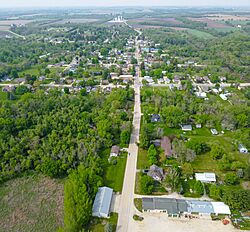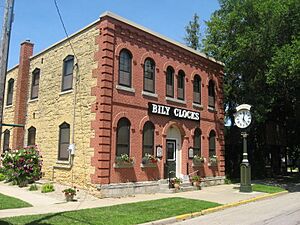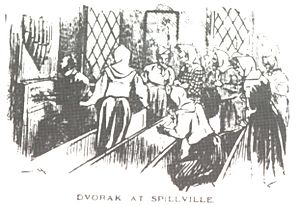Spillville, Iowa facts for kids
Quick facts for kids
Spillville, Iowa
|
|
|---|---|

Turkey River runs through town
|
|
| Nickname(s):
Spillville Fireworks
|
|

Location of Spillville, Iowa
|
|
| Country | |
| State | |
| County | Winneshiek |
| Area | |
| • Total | 0.45 sq mi (1.16 km2) |
| • Land | 0.44 sq mi (1.14 km2) |
| • Water | 0.01 sq mi (0.02 km2) |
| Elevation | 1,070 ft (326 m) |
| Population
(2020)
|
|
| • Total | 385 |
| • Density | 876.99/sq mi (338.41/km2) |
| Time zone | UTC-6 (Central (CST)) |
| • Summer (DST) | UTC-5 (CDT) |
| ZIP code |
52168
|
| Area code(s) | 563 |
| FIPS code | 19-74370 |
| GNIS feature ID | 0461848 |
Spillville is a city in Winneshiek County, Iowa, United States. The population was 385 at the time of the 2020 census. It is located in Calmar Township, approximately 4 mi (6.4 km) west of Calmar and about 12 miles (19 km) southwest of Decorah, the county seat. Spillville is known for its Independence Day fireworks display, held the first Saturday in July.
History
Spillville was platted by German Joseph Spielmann in 1860. Originally named Spielville after the founder, Joseph Spielman, the community's name was misread and became Spillville.
It was largely settled by Bohemian, German and Swiss immigrants.
Spillville boasts a strong cultural and musical history. The Czech composer Antonín Dvořák spent most of 1893 in Spillville, where his friend Josef Jan Kovařík had relatives. There he composed the monumental Symphony No. 9 in E minor, "From the New World", as well as two of his most famous chamber works, the String Quartet in F ("The American") and the String Quintet in E-flat. Spillville is also the site of the Inwood Ballroom, established in 1920 and the destination of several popular 20th-century musicians such as Louis Armstrong, Glenn Miller, Guy Lombardo, and The Byrds. Many tourists to Spillville have also visited the Bily Clocks Museum (see link below), a collection of intricately designed clocks created by two brothers in Spillville housed in the building where Dvořák lived during his stay.
The Roman Catholic parish in Spillville, St. Wenceslaus Church, was built in 1860 and is the oldest Czech Catholic church in the United States.
Geography
Spillville is located at 43°12′N 91°57′W / 43.20°N 91.95°W (43.202, -91.952).
According to the United States Census Bureau, the city has a total area of 0.43 square miles (1.11 km2), of which 0.42 square miles (1.09 km2) is land and 0.01 square miles (0.03 km2) is water.
Demographics
| Historical populations | ||
|---|---|---|
| Year | Pop. | ±% |
| 1880 | 340 | — |
| 1900 | 356 | +4.7% |
| 1910 | 320 | −10.1% |
| 1920 | 315 | −1.6% |
| 1930 | 304 | −3.5% |
| 1940 | 329 | +8.2% |
| 1950 | 363 | +10.3% |
| 1960 | 389 | +7.2% |
| 1970 | 361 | −7.2% |
| 1980 | 415 | +15.0% |
| 1990 | 387 | −6.7% |
| 2000 | 386 | −0.3% |
| 2010 | 367 | −4.9% |
| 2020 | 385 | +4.9% |
| Source: and Iowa Data Center Source: |
||
2020 census
As of the census of 2020, there were 385 people, 173 households, and 103 families residing in the city. The population density was 876.5 inhabitants per square mile (338.4/km2). There were 193 housing units at an average density of 439.4 per square mile (169.6/km2). The racial makeup of the city was 97.4% White, 0.3% Black or African American, 0.0% Native American, 0.3% Asian, 0.0% Pacific Islander, 0.0% from other races and 2.1% from two or more races. Hispanic or Latino persons of any race comprised 0.3% of the population.
Of the 173 households, 27.7% of which had children under the age of 18 living with them, 46.8% were married couples living together, 9.8% were cohabitating couples, 24.9% had a female householder with no spouse or partner present and 18.5% had a male householder with no spouse or partner present. 40.5% of all households were non-families. 34.7% of all households were made up of individuals, 18.5% had someone living alone who was 65 years old or older.
The median age in the city was 40.1 years. 26.8% of the residents were under the age of 20; 4.4% were between the ages of 20 and 24; 25.2% were from 25 and 44; 23.6% were from 45 and 64; and 20.0% were 65 years of age or older. The gender makeup of the city was 46.5% male and 53.5% female.
2010 census
As of the census of 2010, there were 367 people, 168 households, and 96 families living in the city. The population density was 873.8 inhabitants per square mile (337.4/km2). There were 182 housing units at an average density of 433.3 per square mile (167.3/km2). The racial makeup of the city was 96.5% White, 0.3% African American, 0.3% Native American, and 3.0% from other races. Hispanic or Latino of any race were 3.3% of the population.
There were 168 households, of which 26.8% had children under the age of 18 living with them, 50.6% were married couples living together, 4.2% had a female householder with no husband present, 2.4% had a male householder with no wife present, and 42.9% were non-families. 35.7% of all households were made up of individuals, and 21.4% had someone living alone who was 65 years of age or older. The average household size was 2.18 and the average family size was 2.90.
The median age in the city was 42.8 years. 22.3% of residents were under the age of 18; 5.9% were between the ages of 18 and 24; 23.2% were from 25 to 44; 23.3% were from 45 to 64; and 25.1% were 65 years of age or older. The gender makeup of the city was 50.7% male and 49.3% female.
Parks

- Riverside Park & the Inwood Pavilion
Education
The community is within the South Winneshiek Community School District.
CFS Catholic School formed as a consolidation of Catholic schools in Calmar, Festina, and Spillville. Prior to fall 2020 its campuses are St. Aloysius Center in Calmar and St. Wenceslaus Center in Spillville. In 2019 CFS and St. Theresa of Calcutta in Ossian announced plans to consolidate into a single school, with the Calmar campus closing. Beginning fall 2020 the Ossian campus will house grades K-2 and middle school while the Spillville campus will house grades 3–4.
See also
 In Spanish: Spillville (Iowa) para niños
In Spanish: Spillville (Iowa) para niños



